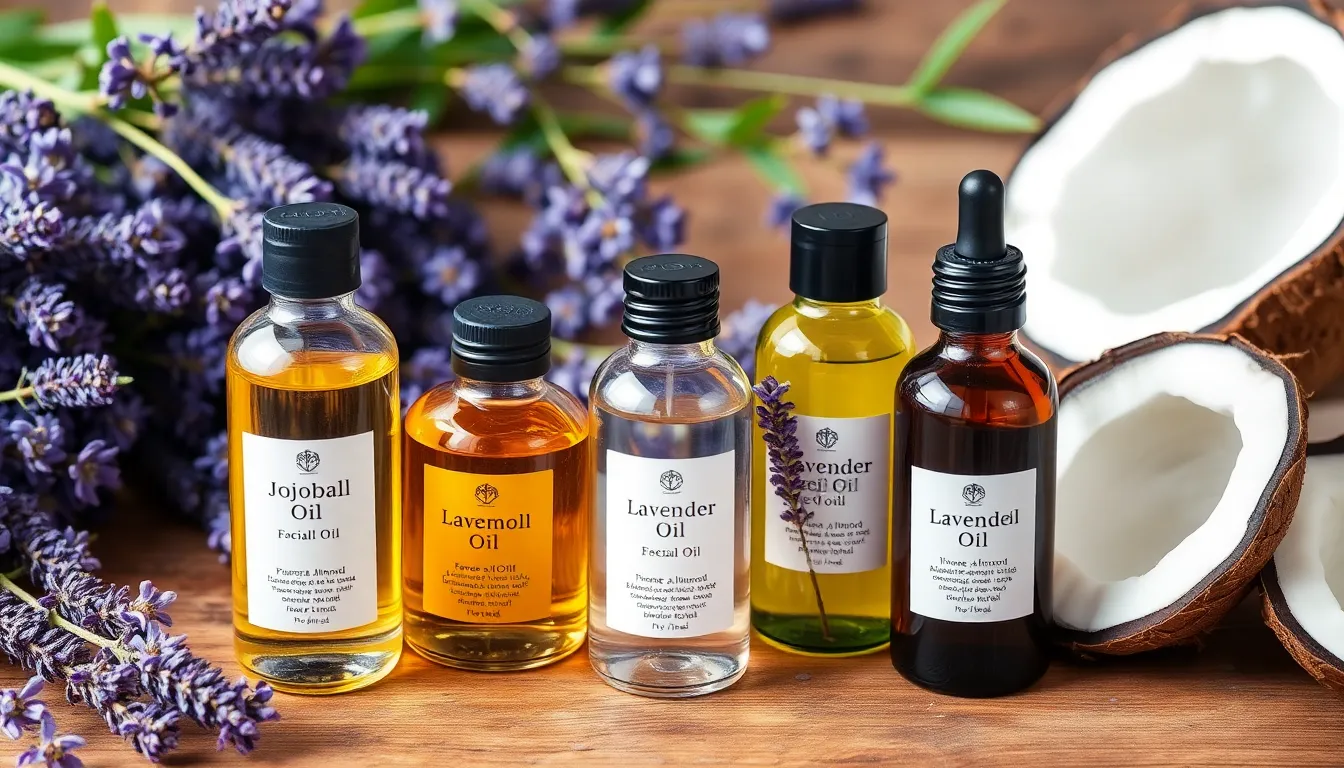In a world where glowing skin often feels like an elusive dream, facial oils might just be the magic potion everyone’s been searching for. These little bottles of liquid gold promise hydration, radiance, and a touch of luxury that’ll have your skin singing like a Broadway star. Who knew that a few drops could transform a tired complexion into a dewy masterpiece?
But wait—before you dismiss facial oils as just another beauty trend, consider this: they’re not just for the dry-skinned among us. Even oily skin can benefit from these botanical wonders. With the right blend, facial oils can balance, nourish, and even help clear up pesky breakouts. So, whether you’re looking to fight signs of aging or simply want to glow like a goddess, it’s time to dive into the world of facial oils and discover the secret to that enviable, radiant complexion.
Table of Contents
ToggleWhat Is Facial Oil?
Facial oil consists of oil-based products designed to hydrate and nourish the skin. Often used in skincare routines, these oils can improve overall skin texture and appearance.
Definition and Purpose
Facial oil refers to concentrated oils specifically formulated for facial application. These products typically contain plant, fruit, or seed oils known for their beneficial properties. The main purpose of facial oils lies in providing moisture, enhancing skin radiance, and delivering essential nutrients. They suit all skin types, including oily and combination skin, offering balancing effects. Using facial oil may improve skin elasticity and contribute to a more youthful appearance.
How It Works on Skin
Facial oils work by creating a barrier that locks in moisture. When applied to the skin, these oils penetrate the outer layer, delivering hydration while preventing water loss. Ingredients such as jojoba and argan oil mimic the skin’s natural oils, promoting balance. The presence of antioxidants in many facial oils helps combat free radical damage. Regular application can lead to softer, healthier skin, enhancing the natural glow.
Types of Facial Oils

Facial oils come in various types, each offering unique benefits for the skin. Understanding these types helps in selecting the right oil for specific skin needs.
Carrier Oils
Carrier oils serve as the base of many facial oil formulations. Common examples include jojoba oil, almond oil, and coconut oil. These oils provide hydration and nourishment while being gentle on the skin. Jojoba oil mimics the skin’s natural sebum, making it suitable for both dry and oily skin types. Sweet almond oil enhances moisture retention, ideal for sensitive skin. Coconut oil offers antibacterial properties, which assist in soothing irritation.
Essential Oils
Essential oils add concentrated benefits to facial oils due to their potent properties. Popular examples include lavender, tea tree, and rose oil. Lavender oil promotes relaxation and calms inflamed skin. Tea tree oil combats acne due to its antibacterial nature. Rose oil, known for its soothing effects, helps reduce redness and improves complexion. These oils must be diluted with carrier oils before application to prevent irritation.
Combination Oils
Combination oils blend both carrier and essential oils, optimizing skin benefits. These formulations often target multiple skin concerns simultaneously. For instance, a combination oil may contain jojoba as a carrier and lavender as an essential oil, addressing hydration and calming irritation. Brands often create specific blends designed to cater to various skin types, ensuring effective nourishment and care. Choose the right combination oil to enhance overall skin health and achieve desired results.
Benefits of Using Facial Oil
Facial oils offer numerous benefits that enhance skin health and appearance. They provide hydration, improve radiance, and can transform the skin’s texture.
Hydration and Moisture Lock
Facial oils deliver deep hydration, essential for maintaining smooth and supple skin. Many oils form a barrier that prevents moisture loss throughout the day. Jojoba oil mimics the skin’s natural sebum, making it suitable for all skin types. Regular use encourages skin elasticity and reduces dryness. As a result, the skin feels nourished and revitalized.
Anti-Aging Properties
Antioxidants found in facial oils combat signs of aging, including fine lines and wrinkles. Oils like rosehip and argan oil contain vitamins A and E, promoting collagen production. These components enhance skin firmness and texture, contributing to a youthful glow. Incorporating facial oils into the skincare routine consistently improves skin vitality. Consequently, the targeted treatment diminishes the appearance of age-related changes.
Skin Barrier Protection
Facial oils strengthen the skin barrier, crucial for overall skin health. By locking in moisture, they help shield against environmental stressors and irritants. Oils rich in fatty acids, such as squalane or marula oil, support barrier function effectively. This protection defends against dryness and irritation, keeping the skin calm and balanced. With regular application, the skin becomes more resilient, leading to a healthy appearance.
How to Choose the Right Facial Oil
Choosing the right facial oil involves understanding your skin type, the ingredients used, and performing necessary tests. Careful selection can enhance skin benefits while minimizing potential irritations.
Skin Type Considerations
Skin type plays a crucial role in selecting facial oils. Oily skin benefits from lightweight oils like jojoba and grapeseed, which help balance oil production. Dry skin, on the other hand, thrives with richer oils such as avocado and argan, providing ample hydration. Sensitive skin requires gentler options like rosehip oil, known for its soothing properties. Combination skin should consider oils that cater to both oily and dry areas, making balance essential in the choice. Ultimately, identifying skin type ensures a tailored approach to oil selection.
Ingredients to Look For
Key ingredients can significantly influence the efficacy of a facial oil. Antioxidant-rich oils like pomegranate and rosehip fight free radicals and promote skin health. Non-comedogenic oils, particularly squalane and sunflower seed oil, minimize the risk of clogged pores. Hydrating properties in oils such as sweet almond and marula support moisture retention. Additionally, essential fatty acids from oils like hemp seed and flaxseed enhance the skin barrier’s functionality. Carefully examining these ingredients contributes to a more informed selection process.
Patch Testing Tips
Patch testing remains essential when incorporating new facial oils. First, apply a small amount of the oil to an inconspicuous area, such as behind the ear or on the wrist. Monitoring the area for 24 to 48 hours helps identify any adverse reactions. If irritation occurs, discontinue use immediately. Those with sensitive skin should be particularly diligent in this testing, while others might still benefit from the precaution. This simple practice ensures that the chosen oil works harmoniously with an individual’s skin.
Application Tips for Facial Oil
Applying facial oil correctly ensures maximum benefits. These tips enhance your skincare routine and promote healthier skin.
How to Incorporate into Skincare Routine
Incorporating facial oil into a skincare routine requires careful timing. Start with clean skin after cleansing and toning. Apply serum or treatment products next, as facial oils lock in moisture. Give the oil some time to absorb before layering additional products. Consider using facial oil both morning and night, depending on your skin type. Utilizing it at night can provide intense hydration while you sleep, allowing for effective rejuvenation.
Best Practices for Application
Applying facial oil involves specific techniques for optimal results. Use only a few drops to avoid greasiness; more does not necessarily mean better. Warm the oil in your hands before application to enhance absorption. Gently press the oil onto the skin, focusing on areas that need extra hydration. Avoid rubbing too harshly, as this can irritate the skin. Avoid contact with the eyes to prevent irritation. Integrating facial oils into a routine should feel soothing and nourishing, enhancing overall skin health.
Facial oils offer a versatile solution for enhancing skin health and appearance. Their unique properties allow for deep hydration and improved texture across all skin types. By forming a protective barrier and delivering essential nutrients, facial oils can rejuvenate the complexion while combating signs of aging.
Selecting the right facial oil tailored to individual skin needs is crucial for optimal results. With various types available, including carrier and essential oils, there’s a suitable option for everyone. Incorporating facial oils into a daily routine can lead to a radiant and youthful glow, making them a valuable addition to any skincare regimen. Embracing the benefits of facial oils can transform one’s approach to skincare, promoting a healthier and more vibrant complexion.



